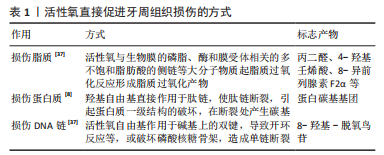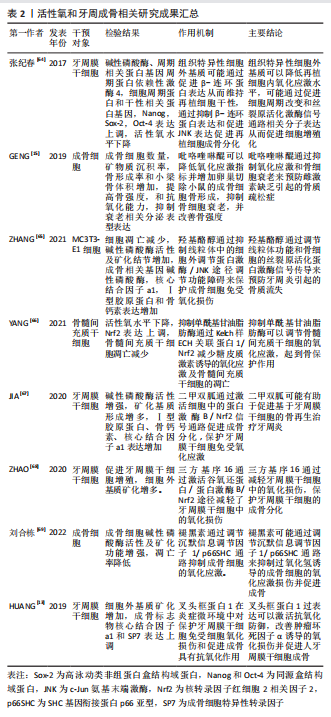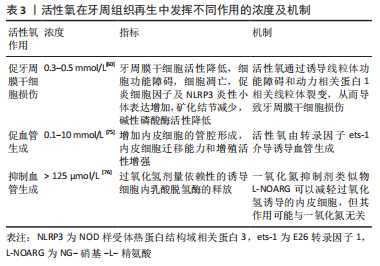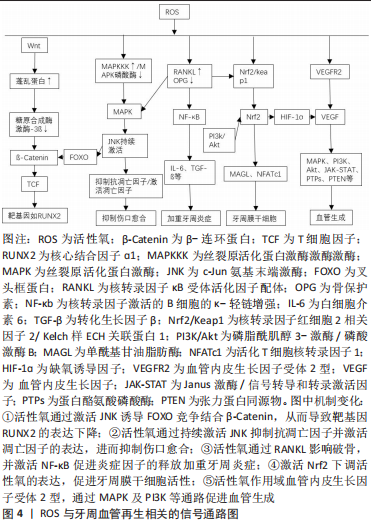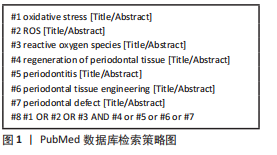[1] ALMERICH-SILLA JM, MONTIEL-COMPANY JM, PASTOR S, et al. Oxidative stress parameters in saliva and its association with periodontal disease and types of bacteria. Dis Markers. 2015;2015:653537.
[2] TAMAKI N, TOMOFUJI T, EKUNI D, et al. Periodontal treatment decreases plasma oxidized LDL level and oxidative stress. Clin Oral Investig. 2011; 15(6):953-958.
[3] HARMAN D. Aging: a theory based on free radical and radiation chemistry. J Gerontol. 1956;11(3):298-300.
[4] MCCORD JM, FRIDOVICH I. Superoxide dismutase. J Biol Chem. 1969;244(22): 6049-6055.
[5] MCCORD JM, FRIDOVICH I. Superoxide dismutases: you’ve come a long way, baby. Antioxid Redox Signal. 2014;20(10):1548-1549.
[6] PANIKER NV, SRIVASTAVA SK, BEUTLER E. Glutathione metabolism of the red cells effect of glutathione reductase deficiency on the stimulation of hexose monophosphate shunt under oxidative stress. Biochim Biophys Acta. 1970;215(3):456-460.
[7] D’AIUTO F, NIBALI L, PARKAR M, et al. Oxidative stress, systemic inflammation, and severe periodontitis. J Dent Res. 2010;89(11):1241-1246.
[8] BALTACIOGLU E, SUKUROGLU E. Protein carbonyl levels in serum, saliva and gingival crevicular fluid in patients with chronic and aggressive periodontitis. Saudi Dent J. 2019;31(1):23-30.
[9] Sczepanik FSC, Grossi ML, CASATI M, et al. Periodontitis is an inflammatory disease of oxidative stress: We should treat it that way. Periodontol 2000. 2020;84(1):45-68.
[10] BABIOR BM, KIPNES RS, CURNUTTE JT. Biological defense mechanisms. the production by leukocytes of superoxide, a potential bactericidal agent. J Clin Invest. 1973;52(3):741-744.
[11] MITTAL CK, MURAD F. Activation of guanylate cyclase by superoxide dismutase and hydroxyl radical: a physiological regulator of guanosine 3’,5’-monophosphate formation. Proc Natl Acad Sci U S A. 1977;74(10):4360-4364.
[12] 方慧,刘琪.牙周炎与活性氧致病机制的研究进展[J].中国医药导报, 2018,15(5):22-26.
[13] HUANG X, CHEN H, XIE Y, et al. FoxO1 Overexpression ameliorates TNF- α -induced oxidative damage and promotes osteogenesis of human periodontal ligament stem cells via antioxidant defense activation. Stem Cells Int. 2019;2019:2120453.
[14] 夏欣怡,陈慧文,胡苡,等.硫酸吲哚酚对人牙周膜细胞增殖及炎症因子表达的影响[J].上海交通大学学报(医学版),2020,40(4):437-442.
[15] GENG Q, GAO H, YANG R, et al. Pyrroloquinoline quinone prevents estrogen deficiency-induced osteoporosis by inhibiting oxidative stress and osteocyte senescence. Int J Bio Sci. 2019;15(1):58-68.
[16] ZHU L, XIE H, LIU Q, et al. Klotho inhibits H2O2 ‐induced oxidative stress and apoptosis in periodontal ligament stem cells by regulating UCP2 expression. Clin Exp Pharmacol and Physiol. 2021;48(10):1412-1420.
[17] 庄齐翔,董家辰,束蓉.釉基质蛋白衍生物对牙周组织再生相关细胞的生物学作用及其成血管作用的研究进展[J].上海交通大学学报(医学版),2021,41(8):1099-1102.
[18] KIM YW, BYZOVA TV. Oxidative stress in angiogenesis and vascular disease. Blood. 2014;123(5):625-631.
[19] DI MEO S, REED TT, Venditti P, et al. Role of ROS and RNS sources in physiological and pathological conditions. Oxid Med Cell Longev. 2016; 2016:1245049.
[20] WANG Y, ANDRUKHOV O, RAUSCH-FAN X. Oxidative stress and antioxidant system in periodontitis. Front Physiol. 2017;8:910.
[21] 王芃,吴立鹏.活性氧在牙周炎发生发展转归中的作用和意义综述[J].牡丹江医学院学报,2019,40(4):90-91.
[22] XU X. The role of reactive oxygen species and autophagy in periodontitis and their potential linkage. Front Physiol. 2017;8:439.
[23] 袁一方,陈晓涛.活性氧类在慢性牙周炎所致骨吸收中的研究进展[J].医学综述,2022,28(4):666-670.
[24] BASER U, GAMSIZ-ISIK H, CIFCIBASI E,et al. Plasma and salivary total antioxidant capacity in healthy controls compared with aggressive and chronic periodontitis patients. Saudi Med J. 2015;36(7):856-861.
[25] JIANG Q, ZHAO Y, SHUI Y, et al. Interactions between neutrophils and periodontal pathogens in late-onset periodontitis. Front Cell Infect Microbiol. 2021;11:627328.
[26] KANG W, JIA Z, TANG D, et al. Fusobacterium nucleatum facilitates apoptosis, ros generation, and inflammatory cytokine production by activating AKT/MAPK and NF-κB signaling pathways in human gingival fibroblasts. Oxid Med Cell Longev. 2019;2019:1681972.
[27] MIKOLAI C, BRANITZKI-HEINEMANN K, INGENDOH-TSAKMAKIDIS A, et al. Neutrophils exhibit an individual response to different oral bacterial biofilms. J Oral Microbiol. 2020;13(1):1856565.
[28] CHEAT B, TORRENS C, FODA A, et al. NLRP3 is involved in neutrophil mobilization in experimental periodontitis. Front Immunol. 2022;13:839929.
[29] YIN W, LIU S, DONG M, et al. A new NLRP3 inflammasome inhibitor, dioscin, promotes osteogenesis. Small. 2020;16(1):e1905977.
[30] ISOLA G, POLIZZI A, SANTONOCITO S, et al. Periodontitis activates the NLRP3 inflammasome in serum and saliva. J Periodontol. 2022;93(1):135-145.
[31] ISAZA-GUZMÁN DM, MEDINA-PIEDRAHÍTA VM, GUTIÉRREZ-HENAO C, et al. Salivary levels of NLRP3 inflammasome-related proteins as potential biomarkers of periodontal clinical status. J Periodontol. 2017;88(12):1329-1338.
[32] LIAN D, DAI L, XIE Z, et al. Periodontal ligament fibroblasts migration injury via ROS/TXNIP/Nlrp3 inflammasome pathway with Porphyromonas gingivalis lipopolysaccharide. Mol Immunol. 2018;103:209-219.
[33] ZHU R, MI X, LI Y. Effects of hypoxic environment on periodontal tissue through the ROS/TXNIP/NLRP3 inflammasome pathway. Biomed Res Int. 2022;2022:7690960.
[34] MATTHEWS JB, WRIGHT HJ, ROBERTS A, et al. Hyperactivity and reactivity of peripheral blood neutrophils in chronic periodontitis. Clin Exp Immunol. 2007;147(2):255-264.
[35] BONINI MG, MALIK AB. Regulating the regulator of ROS production. Cell Res. 2014;24(8):908-909.
[36] MARTINEZ‐HERRERA M, LÓPEZ‐DOMÈNECH S, SILVESTRE FJ, et al. Chronic periodontitis impairs polymorphonuclear leucocyte-endothelium cell interactions and oxidative stress in humans. J Clin Periodontol. 2018;45(12): 1429-1439.
[37] CHEN M, CAI W, ZHAO S, et al. Oxidative stress‐related biomarkers in saliva and gingival crevicular fluid associated with chronic periodontitis: a systematic review and meta‐analysis. J Clin Periodontol. 2019;46(6):608-622.
[38] FOUQUEREL E, BARNES RP, UTTAM S, et al. Targeted and persistent 8-oxoguanine base damage at telomeres promotes telomere loss and crisis. Mol cell. 2019;75(1):117-130.e6.
[39] CHEN Y, JI Y, JIN X, et al. Mitochondrial abnormalities are involved in periodontal ligament fibroblast apoptosis induced by oxidative stress. Biochem and Biophys Res Commun. 2019;509(2):483-490.
[40] PRASAD S, GUPTA SC, TYAGI AK. Reactive oxygen species (ROS) and cancer: Role of antioxidative nutraceuticals. Cancer Lett. 2017;387:95-105.
[41] PATIL VIDYA S. Chronic periodontitis in type 2 diabetes mellitus: oxidative stress as a common factor in periodontal tissue injury. J Clin Diagn Res. 2016;10(4):BC12-6.
[42] GHARBI A, HAMILA A, BOUGUEZZI A, et al. Biochemical parameters and oxidative stress markers in Tunisian patients with periodontal disease. BMC Oral Health. 2019;19(1):225.
[43] SIES H, JONES DP. Reactive oxygen species (ROS) as pleiotropic physiological signalling agents. Nat Rev Mol Cell Biol. 2020;21(7):363-383.
[44] 李芊芊,彭双清.活性氧对NF-κB活性及JNK信号通路的调节[J].生物技术通讯,2008,19(4):611-614.
[45] BURANASIN P, MIZUTANI K, IWASAKI K, et al. High glucose-induced oxidative stress impairs proliferation and migration of human gingival fibroblasts. PloS One. 2018;13(8):e0201855.
[46] WANG Q, SZTUKOWSKA M, OJO A, et al. FOXO responses to Porphyromonas gingivalis in epithelial cells. Cell Microbiol. 2015;17(11):1605-1617.
[47] LI H, SUN T, LIU C, et al. Photobiomodulation (450 nm) alters the infection of periodontitis bacteria via the ROS/MAPK/mTOR signaling pathway. Free Radic Biol Med. 2020;152:838-853.
[48] 郝瑞,贺菲菲,梁艳,等.糖尿病合并牙周炎患者龈沟液中OPG/RANKL表达与炎症因子、自由基生成及骨代谢的相关性[J].海南医学院学报, 2018,24(5):585-588.
[49] KIM JH, KIM K, KIM I, et al. NRROS negatively regulates osteoclast differentiation by inhibiting RANKL-mediated NF-κB and reactive oxygen species pathways. Mol Cells. 2015;38(10):904-910.
[50] 吴赛璇,张咪,董明,等.骨稳态过程中Keap1/Nrf2/ARE信号通路的调控作用[J].中国组织工程研究,2022,26(2):271-275.
[51] 沈振国,赵荣权,欧琳琳,等.微环境下Wnt/β-catenin通路参与牙周膜干细胞骨向分化机制的研究进展[J].安徽医科大学学报,2021,56(3): 497-500.
[52] 程韶,舒冰,赵永见,等.氧化应激对骨重建的影响[J].中国骨质疏松杂志,2019,25(10):1478-1482.
[53] GALLI C, PASSERI G, MACALUSO GM. FoxOs, Wnts and oxidative stressinduced bone loss: new players in the periodontitis arena? J Periodontal Res. 2011;46(4):397-406.
[54] WANG YN, JIA TT, FENG Y, et al. Hyperlipidemia impairs osseointegration via the ROS/Wnt/β-catenin pathway. J Dent Res. 2021;100(6):658-665.
[55] SEO BM, MIURA M, GRONTHOS S, et al. Investigation of multipotent postnatal stem cells from human periodontal ligament. Lancet. 2004;364 (9429):149-155.
[56] 王文娟,严妍,张凤秋.炎症微环境下牙周膜干细胞胞内ROS的表达[J].北京口腔医学,2022,30(3):171-175.
[57] WENG Y, WANG H, LI L, et al. Trem2 mediated Syk-dependent ROS amplification is essential for osteoclastogenesis in periodontitis microenvironment. Redox Biol. 2021;40:101849.
[58] LI X, LI B, SHI Y, et al. Targeting reactive oxygen species in stem cells for bone therapy. Drug Discov Today. 2021;26(5):1226-1244.
[59] WANG ML, HAUSCHKA PV, TUAN RS, et al. Exposure to particles stimulates superoxide production by human THP-1 macrophages and avian HD-11EM osteoclasts activated by tumor necrosis factor-alpha and PMA. J Arthroplasty. 2002;17(3):335-346.
[60] SHI L, JI Y, ZHAO S, et al. Crosstalk between reactive oxygen species and dynamin-related protein 1 in periodontitis. Free Radic Biol and Med. 2021; 172:19-32.
[61] JIAO H, XIAO E, GRAVES DT. Diabetes and Its Effect on Bone and Fracture Healing. Curr Osteoporos Rep. 2015;13(5):327-335.
[62] GUO Z, MO Z. Keap1-Nrf2 signaling pathway in angiogenesis and vascular diseases. J Tissue Eng Regen Med. 2020;14(6):869-883.
[63] BHATTARAI G, POUDEL SB, KOOK SH, et al. Resveratrol prevents alveolar bone loss in an experimental rat model of periodontitis. Acta Biomater. 2016;29:398-408.
[64] 张纪春.牙周膜细胞来源细胞外基质在牙周组织再生的实验研究[D].上海:上海交通大学,2017.
[65] ZHANG X, JIANG Y, MAO J, et al. Hydroxytyrosol prevents periodontitis-induced bone loss by regulating mitochondrial function and mitogen-activated protein kinase signaling of bone cells. Free Radic Biol Med. 2021; 176:298-311.
[66] YANG N, SUN H, XUE Y, et al. Inhibition of MAGL activates the Keap1/Nrf2 pathway to attenuate glucocorticoid‐induced osteonecrosis of the femoral head. Clin Transl Med. 2021;11(6):e447.
[67] JIA L, XIONG Y, ZHANG W, et al. Metformin promotes osteogenic differentiation and protects against oxidative stress-induced damage in periodontal ligament stem cells via activation of the Akt/Nrf2 signaling pathway. Exp Cell Res. 2020;386(2):111717.
[68] ZHAO Y, LIU H, XI X, et al. TRIM16 protects human periodontal ligament stem cells from oxidative stress-induced damage via activation of PICOT. Exp Cell Res. 2020;397(1):112336.
[69] 刘合栋,任茂贤,李杨,等.褪黑素对H₂O₂诱导的成骨细胞氧化应激损伤的保护作用[J].中国骨质疏松杂志,2022,28(8):1093-1098.
[70] FUKAI T, USHIO-FUKAI M. Cross-talk between NADPH oxidase and mitochondria: role in ROS signaling and angiogenesis. Cells. 2020;9(8):1849.
[71] AUGUSTINE R, PRASAD P, KHALAF IMN. Therapeutic angiogenesis: from conventional approaches to recent nanotechnology-based interventions. Materials Sci Eng C Mater Biol Appl. 2019;97:994-1008.
[72] MCGARRY T, BINIECKA M, VEALE DJ, et al. Hypoxia, oxidative stress and inflammation. Free Radic Biol Med. 2018;125:15-24.
[73] ZICHE M, MORBIDELLI L. Nitric oxide and angiogenesis. JNeurooncol. 2000; 50(1):139-148.
[74] SCOTT E, LOYA K, MOUNTFORD J, et al. MicroRNA regulation of endothelial homeostasis and commitment-implications for vascular regeneration strategies using stem cell therapies. Free Radic Biol Med. 2013;64:52-60.
[75] YASUDA M, OHZEKI Y, SHIMIZU S, et al. Stimulation of in vitro angiogenesis by hydrogen peroxide and the relation with ETS-1 in endothelial cells. Life Sci. 1999;64(4):249-258.
[76] SHIMIZU S, NOMOTO M, YAMAMOTO T, et al. Reduction by NG-nitro-L-arginine of H2O2-induced endothelial cell injury. Br J Pharmacol. 1994; 113(2):564-568.
[77] HUANG X, LIANG P, JIANG B, et al. Hyperbaric oxygen potentiates diabetic wound healing by promoting fibroblast cell proliferation and endothelial cell angiogenesis. Life Sci. 2020;259:118246. |


